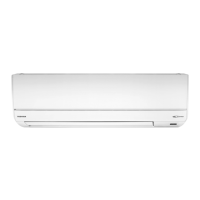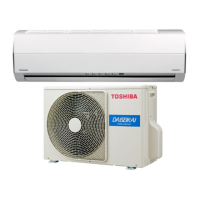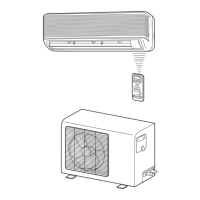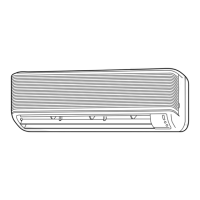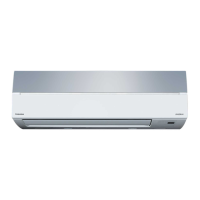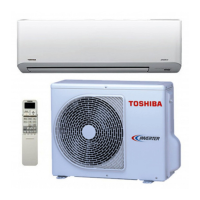Do you have a question about the Toshiba RAS-10SAVR-E and is the answer not in the manual?
Detailed specifications for indoor and outdoor units, including capacities, power, noise, and dimensions.
Visual representation of cooling and heating operation characteristics based on compressor speed.
Graphs showing how cooling and heating capacity ratios vary with outdoor temperature.
Essential safety precautions for handling R410A refrigerant during installation and servicing.
Guidelines for installing refrigerant piping, including materials, dimensions, and processing.
Lists tools specifically required for R410A installations and their interchangeability.
Details on silver brazing filler, phosphor bronze filler, and low-temperature brazing filler.
Explains the necessity and characteristics of flux used in brazing.
Exploded view and dimensions of the indoor unit.
Exploded view and dimensions for different indoor unit models.
Exploded view and dimensions of the outdoor unit.
Wiring diagram for specific indoor and outdoor unit models.
Wiring diagram for specific indoor and outdoor unit models.
List of electrical components and their specifications for indoor units.
List of electrical components and their specifications for outdoor units.
Diagram illustrating the refrigerant flow path within the air conditioning system.
Block diagram showing the control logic and components of the indoor unit.
Block diagram detailing the control system of the outdoor unit, including the inverter.
General overview of the air conditioner's control system and its components.
Explanation of various operation modes like cooling, heating, auto, and dry operations.
Information on setting, cancelling, and behavior during power failure of the auto restart feature.
Details on remote controller functions, buttons, and operation modes.
Explanation of the symbols and indicators displayed on the remote controller.
Safety warnings and precautions to be observed before and during installation.
List of optional parts, accessories, and tools required for installation.
Details on tools specific to R410A and differences from R22 tools.
Instructions for installing the indoor unit, including placement and mounting.
Guidelines for electrical connections, power source, and wiring requirements.
Step-by-step instructions for connecting the indoor unit's wiring.
Procedures for installing refrigerant piping and drain hoses, including insulation.
Detailed steps for physically mounting and securing the indoor unit.
Instructions for ensuring proper drainage of condensation from the indoor unit.
Guidelines for selecting an appropriate installation location for the outdoor unit.
Instructions for proper drainage of defrost water from the outdoor unit.
Detailed procedures for connecting refrigerant pipes, including flaring.
Steps for evacuating air from the refrigerant lines using a vacuum pump.
Instructions for connecting the outdoor unit's power and control wiring.
Procedures for performing initial system tests after installation, including gas leak and operational checks.
Instructions on how to enable or disable the auto restart function.
Guidance on setting remote controller selection for multi-unit installations.
Initial checks for power supply, voltage, and expected operational behavior.
Methods for initial troubleshooting based on flashing LEDs and basic checks.
Interpreting error codes indicated by flashing LEDs on the indoor unit.
Using the remote controller in service mode to retrieve diagnostic check codes.
Important safety precautions and procedures to follow when servicing electrical components.
Troubleshooting guide based on common symptoms and system behavior.
Troubleshooting steps for issues related to the indoor unit and remote controller operation.
Diagnosing issues related to wiring faults between indoor and outdoor units.
Troubleshooting specific error codes related to miswiring or sensor issues.
Procedure to test the functionality of the air purifier component.
Procedure to test the functionality of the minus ion generator.
Troubleshooting steps for the outdoor unit's inverter assembly.
Procedures for checking the indoor unit's main P.C. board for defects.
Visual layout and component identification for the indoor unit's P.C. board.
Checking procedures for indoor unit parts and outdoor unit components.
Methods for checking specific electronic parts like capacitors and diodes.
Diagnostic steps to determine the condition of the outdoor fan motor.
Procedures for disassembling and replacing the front panel and related components of the indoor unit.
Instructions for accessing and replacing the microcomputer and associated P.C. boards.
Steps for disassembling and reassembling the outdoor unit's main cabinets.
Exploded view and parts list for the indoor unit, covering main components.
Exploded view and parts list for the indoor unit, detailing electronic components.
Exploded view and parts list for the outdoor unit, showing major assemblies.
Diagram showing the layout of components on the P.C. boards.
Detailed specifications for indoor and outdoor units, including capacities, power, noise, and dimensions.
Visual representation of cooling and heating operation characteristics based on compressor speed.
Graphs showing how cooling and heating capacity ratios vary with outdoor temperature.
Essential safety precautions for handling R410A refrigerant during installation and servicing.
Guidelines for installing refrigerant piping, including materials, dimensions, and processing.
Lists tools specifically required for R410A installations and their interchangeability.
Details on silver brazing filler, phosphor bronze filler, and low-temperature brazing filler.
Explains the necessity and characteristics of flux used in brazing.
Exploded view and dimensions of the indoor unit.
Exploded view and dimensions for different indoor unit models.
Exploded view and dimensions of the outdoor unit.
Wiring diagram for specific indoor and outdoor unit models.
Wiring diagram for specific indoor and outdoor unit models.
List of electrical components and their specifications for indoor units.
List of electrical components and their specifications for outdoor units.
Diagram illustrating the refrigerant flow path within the air conditioning system.
Block diagram showing the control logic and components of the indoor unit.
Block diagram detailing the control system of the outdoor unit, including the inverter.
General overview of the air conditioner's control system and its components.
Explanation of various operation modes like cooling, heating, auto, and dry operations.
Information on setting, cancelling, and behavior during power failure of the auto restart feature.
Details on remote controller functions, buttons, and operation modes.
Explanation of the symbols and indicators displayed on the remote controller.
Safety warnings and precautions to be observed before and during installation.
List of optional parts, accessories, and tools required for installation.
Details on tools specific to R410A and differences from R22 tools.
Instructions for installing the indoor unit, including placement and mounting.
Guidelines for electrical connections, power source, and wiring requirements.
Step-by-step instructions for connecting the indoor unit's wiring.
Procedures for installing refrigerant piping and drain hoses, including insulation.
Detailed steps for physically mounting and securing the indoor unit.
Instructions for ensuring proper drainage of condensation from the indoor unit.
Guidelines for selecting an appropriate installation location for the outdoor unit.
Instructions for proper drainage of defrost water from the outdoor unit.
Detailed procedures for connecting refrigerant pipes, including flaring.
Steps for evacuating air from the refrigerant lines using a vacuum pump.
Instructions for connecting the outdoor unit's power and control wiring.
Procedures for performing initial system tests after installation, including gas leak and operational checks.
Instructions on how to enable or disable the auto restart function.
Guidance on setting remote controller selection for multi-unit installations.
Initial checks for power supply, voltage, and expected operational behavior.
Methods for initial troubleshooting based on flashing LEDs and basic checks.
Interpreting error codes indicated by flashing LEDs on the indoor unit.
Using the remote controller in service mode to retrieve diagnostic check codes.
Important safety precautions and procedures to follow when servicing electrical components.
Troubleshooting guide based on common symptoms and system behavior.
Troubleshooting steps for issues related to the indoor unit and remote controller operation.
Diagnosing issues related to wiring faults between indoor and outdoor units.
Troubleshooting specific error codes related to miswiring or sensor issues.
Procedure to test the functionality of the air purifier component.
Procedure to test the functionality of the minus ion generator.
Troubleshooting steps for the outdoor unit's inverter assembly.
Procedures for checking the indoor unit's main P.C. board for defects.
Visual layout and component identification for the indoor unit's P.C. board.
Checking procedures for indoor unit parts and outdoor unit components.
Methods for checking specific electronic parts like capacitors and diodes.
Diagnostic steps to determine the condition of the outdoor fan motor.
Procedures for disassembling and replacing the front panel and related components of the indoor unit.
Instructions for accessing and replacing the microcomputer and associated P.C. boards.
Steps for disassembling and reassembling the outdoor unit's main cabinets.
Exploded view and parts list for the indoor unit, covering main components.
Exploded view and parts list for the indoor unit, detailing electronic components.
Exploded view and parts list for the outdoor unit, showing major assemblies.
Diagram showing the layout of components on the P.C. boards.
| Cooling Capacity | 2.5 kW |
|---|---|
| Heating Capacity | 3.2 kW |
| EER | 3.21 |
| COP | 3.61 |
| Refrigerant | R410A |
| Power Supply | 220-240V, 50Hz |
| Energy Efficiency Ratio (EER) | 3.21 |
| Coefficient of Performance (COP) | 3.61 |
| Indoor Unit Weight | 9 kg |
| Type | Split Type |
| Noise Level (Outdoor) | 48 dB(A) |
